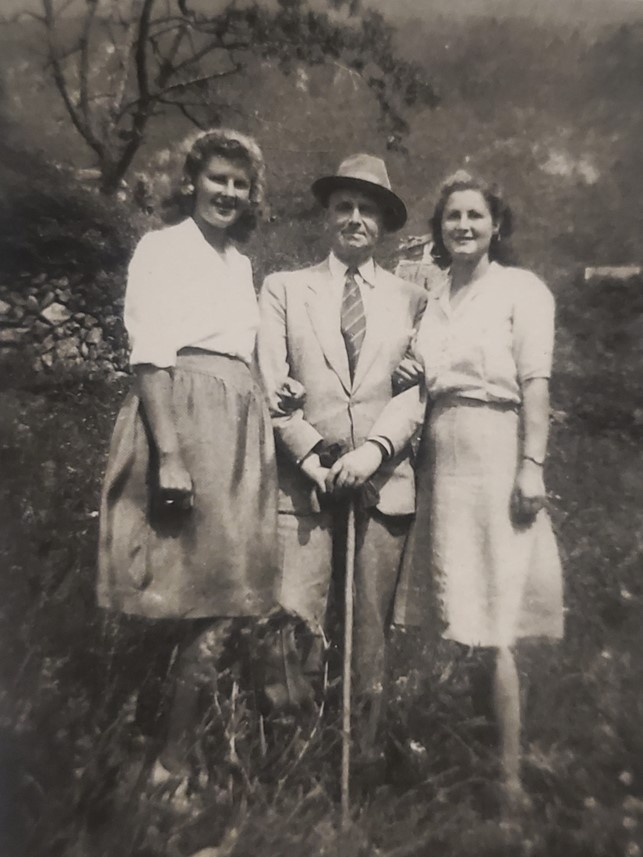My husband Charles Bernard Gliksohn is named after his two maternal uncles who died at Auschwitz. We know Bernard Schönberg ‘s career. Chief Rabbi of Lyon, he was arrested in Ambérieu-en-Bugey while visiting his mother. Held at Fort de Montluc and then Drancy, he was deported to Auschwitz on convoy 62 on November 20, 1943, where he died of exhaustion on February 6, 1944. We knew nothing about Charles Schönberg, only that he had died in Auschwitz. The only thing passed on by my husband’s mother was that “he was unlucky”. In 2020, with the help of my son Antoine, I set about researching as much information as possible about Charles, in order to retrace his career.
The first step in our search was to find his first name, as Charles was the first name used by the family, but not his legal name. Research into various documents revealed that his legal name was Osias Schönberg.
After taking refuge in Nîmes with his brother Edmond, Osias, who did not have French nationality, was arrested and detained at the Rivesaltes camp. He escaped and then took refuge in the Italian-occupied zone. Under house arrest in Saint-Martin-Vésubie, he fled to Italy, where he went into hiding. He was arrested in San Michele on May 25, 1944, held in Cuneo prison and then transferred to Turin, from where he was deported on August 1, 1944, before being murdered in Auschwitz on August 8, 1944. Some of this information was found in the book written by Alberto Cavaglion, “Les juifs de Saint-Martin-Vésubie”.
In 2022, we took part in the Marche de la Mémoire, where my husband was able to bear witness to his uncle’s newly discovered story.
We thought we’d found all we could find, but this 80th birthday brought us what we’d dared not hope for: a photograph in which he would be identified. No photos of him had been passed down through the family.
On August 20, the publication of Linda Rosenblatt’s testimony changed everything. There’s a group photo, and one of the people in it is Osias Schönberg. You can imagine our emotion when we saw his face for the first time.
Linda Rosenblatt tells us that this photo is taken from Danielle Baudot Laksine ‘s book “Les grands visiteurs, La pierre des juifs tome 2”. In this book we found another photograph in which he is identified with Manya Hartmayer, Alice Dobis and Eliane Ingigliardi at the wedding of Sidi Templer and Alter Sharon. We also found the following passage from Manya Hartmayer’s testimony: “Dad, who had escaped from another camp in France but was turned back at the Swiss border, had reached Nice thanks to his friend Schomberg.” We now know that Osias was a friend of the Hartmayer family.
Searching family photos, we think we’ve found a photo of Osias with two young women. The context suggests that this photo was taken in Saint-Martin-Vésubie.

We are trying to identify the two young women. If anyone recognizes them, we’d be very grateful if you’d let us know.
Little by little, Charles/Osias Schönberg emerges from the darkness into which Nazi Germany wanted to plunge him, along with 6 million other human beings denied the right to live.
We would like to thank David and the AME43 association for this wonderful initiative to publish testimonials, and Linda Rosenblatt for her help in directing us to Danielle Baudot Laksine’s book.
Béatrice Jouanne
My husband Charles Bernard Gliksohn is the son of Ignace “Robert” Gliksohn and Hene “Hélène” Schönberg. Hene is the younger sister of Bernard and Charles Schönberg. The Gliksohn and Schönberg families came to France from Poland between 1910 and 1914. My husband was born on September 13, 1951. He had an older brother, Jean-Michel, born on August 10, 1945. When he was born, his mother still hoped for the return of his two brothers, but when her second son was born she decided to give him the names of his two brothers who died in the deportation.
My name is Béatrice Jouanne, I was born on May 18 1955 and I’m not from a Jewish family. My marriage to Charles Bernard (whom I simply call Bernard) and the birth of my three children naturally immersed me in his family history. I quickly realized how important it was to find out as much as possible about the Gliksohn and Schönberg families. At first, I used the memories of the older generation, but it was only when the civil registers of France and especially Poland became available online that I was able to make real progress in my genealogical research. There were still some unknowns, however, not least the history and fate of Charles Schönberg.
It’s important, and you’re doing your part, to bring to light these stories that show both the absurdity and horror of such persecution, the strength, resistance and resilience of those who survived, and the courage and self-sacrifice of those who helped them. We need to bear this in mind when today many persecuted people flee their countries at the risk of their lives in search of a better life for themselves and their families.
